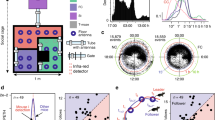Abstract
Thermoregulatory huddling behaviours dominate the early experiences of developing rodents, and constrain the patterns of sensory and motor input that drive neural plasticity. Huddling is a complex emergent group behaviour, thought to provide an early template for the development of adult social systems, and to constrain natural selection on metabolic physiology. However, huddling behaviours are governed by simple rules of interaction between individuals, which can be described in terms of the thermodynamics of heat exchange, and can be easily controlled by manipulation of the environment temperature. Thermoregulatory huddling thus provides an opportunity to investigate the effects of early experience on brain development in a social, developmental, and evolutionary context, through controlled experimentation. This paper demonstrates that thermoregulatory huddling behaviours can self-organise in a simulation of rodent littermates modelled as soft-deformable bodies that exchange heat during contact. The paper presents a novel methodology, based on techniques in computer animation, for simulating the early sensory and motor experiences of the developing rodent.
Access this chapter
Tax calculation will be finalised at checkout
Purchases are for personal use only
Similar content being viewed by others
References
Schank, J.C., Alberts, J.R.: The developmental emergence of coupled activity as cooperative aggregation in rat pups. Proc. Biol. Sci. 267(1459), 2307–2315 (2000)
Gilbert, C., McCafferty, D., Le Maho, Y., Martrette, J.M., Giroud, S., Blanc, S., Ancel, A.: One for all and all for one: the energetic benefits of huddling in endotherms. Biol. Rev. 85(3), 545–569 (2010). Cambridge Philosophical Society
Canals, M., Bozinovic, F.: Huddling behavior as critical phase transition triggered by low temperatures. Complexity 17(1), 35–43 (2011)
Alberts, J.R.: Huddling by rat pups: ontogeny of individual and group behavior. Dev. Psychobiol. 49(1), 22–32 (2007)
Schank, J.C., Alberts, J.R.: Self-organized huddles of rat pups modeled by simple rules of individual behavior. J. Theor. Biol. 189(1), 11–25 (1997)
Glancy, J., Gross, R., Stone, J., Wilson, S.P.: A self-organising model of thermoregulatory huddling. PLoS Comput. Biol. 11(9), e1004283 (2015)
Canals, M.R., Rosenmann, M., Bozinovic, F.: Geometrical aspects of the energetic effectiveness of huddling in small mammals. Acta Theriol. 42(3), 321–328 (1997)
May, C.J., Schank, J.C., Joshi, S., Tran, J., Taylor, R.J., Scott, I.E.: Rat pups and random robots generate similar self-organized and intentional behavior. Complexity 12(1), 53–66 (2006)
Schank, J.C.: The development of locomotor kinematics in neonatal rats: an agent-based modeling analysis in group and individual contexts. J. Theor. Biol. 254(4), 826–842 (2008)
Wilson, S.P.: Self-organised criticality in the evolution of a thermodynamic model of rodent thermoregulatory huddling. PLoS Comput. Biol. 13(1), e1005378 (2017)
Müller, M., Heidelberger, B., Teschner, M., Gross, M.: Meshless deformations based on shape matching. ACM Trans. Graph. 24(3), 471–478 (2005)
Urashima, H., Wilson, S.P.: A self-organising animat body map. In: Duff, A., Lepora, N.F., Mura, A., Prescott, T.J., Verschure, P.F.M.J. (eds.) Living Machines 2014. LNCS, vol. 8608, pp. 439–441. Springer, Cham (2014). doi:10.1007/978-3-319-09435-9_55
Stafford, T., Wilson, S.P.: Self-organisation can generate the discontinuities in the somatosensory map. Neurocomputing 70, 1932–1937 (2007)
Wilson, S.P., Law, J.S., Mitchinson, B., Prescott, T.J., Bednar, J.A.: Modeling the emergence of whisker direction maps in rat barrel cortex. PLoS ONE 5(1), e8778 (2010)
McGregor, S., Polani, D., Dautenhahn, K.: Generation of tactile maps for artificial skin. PLoS ONE 6(11), e26561 (2011)
Wilson, S.P., Bednar, J.A.: What, if anything, are topological maps for? Dev. Neurobiol. 75(6), 667–681 (2015)
Bednar, J.A., Wilson, S.P.: Cortical maps. Neuroscientist 22(6), 604–617 (2016)
Glancy, J., Stone, J.V., Wilson, S.P.: How self-organization can guide evolution. Roy. Soc. Open Sci. 3(11) (2016)
Vicsek, T., Czirók, A., Ben-Jacob, E., Cohen, I., Shochet, O.: Novel type of phase transition in a system of self-driven particles. Phys. Rev. Lett. 75, 1226–1229 (1995)
Wilson, S.P.: The synthetic littermate. In: Lepora, N.F., Mura, A., Krapp, H.G., Verschure, P.F.M.J., Prescott, T.J. (eds.) Living Machines 2013. LNCS, vol. 8064, pp. 450–453. Springer, Heidelberg (2013). doi:10.1007/978-3-642-39802-5_63
Author information
Authors and Affiliations
Corresponding author
Editor information
Editors and Affiliations
Rights and permissions
Copyright information
© 2017 Springer International Publishing AG
About this paper
Cite this paper
Wilson, S.P. (2017). Self-organising Thermoregulatory Huddling in a Model of Soft Deformable Littermates. In: Mangan, M., Cutkosky, M., Mura, A., Verschure, P., Prescott, T., Lepora, N. (eds) Biomimetic and Biohybrid Systems. Living Machines 2017. Lecture Notes in Computer Science(), vol 10384. Springer, Cham. https://doi.org/10.1007/978-3-319-63537-8_41
Download citation
DOI: https://doi.org/10.1007/978-3-319-63537-8_41
Published:
Publisher Name: Springer, Cham
Print ISBN: 978-3-319-63536-1
Online ISBN: 978-3-319-63537-8
eBook Packages: Computer ScienceComputer Science (R0)




